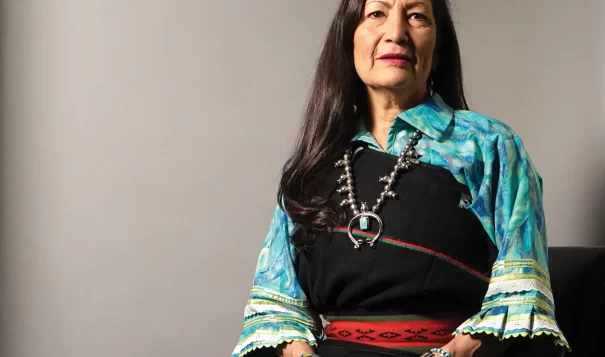News Based on facts, either observed and verified directly by the reporter, or reported and verified from knowledgeable sources.
Deb Haaland’s Road to Healing tour stops in Arizona
 Courtesy Office Of Congresswoman Deb Haaland
Courtesy Office Of Congresswoman Deb Haaland
WARNING: This story contains disturbing details about residential and boarding schools. If you are feeling triggered, here is a resource list for trauma responses from the National Native American Boarding School Healing Coalition in the U.S. In Canada, the National Indian Residential School Crisis Hotline can be reached at 1-866-925-4419.
GILA RIVER INDIAN COMMUNITY — Former students of a boarding school system operated by the federal government shared their experiences, trauma and resilience in remarks to officials from the U.S. Department of the Interior on Friday in Arizona.
The former students, citizens of tribes from across Arizona, directed their comments to Interior Secretary Deb Haaland, Laguna Pueblo, in Komatke, a community south of Phoenix on the Gila River Indian Community.
What they experienced – from good times with friends to the harsh reality of abuse – is what Haaland wanted to hear.
“I will listen. I will grieve with you. I will weep alongside you and I will feel the pain that you feel,” Haaland said in her opening remarks in her latest Road to Healing tour stop.
Former students have been speaking out – some of them for the first time – during a national listening tour being conducted by the Interior. The Gila River Indian Community is the fourth tribal area that Interior officials have visited on the tour. A second Arizona stop is set for Sunday when officials visit the Navajo Nation at Many Farms High School in Many Farms.
Federal officials are traveling to states where boarding schools were located to gather oral testimonies from students about the treatment they endured at the schools and the long-term suffering it caused. Previous stops have been in South Dakota, Oklahoma and Michigan.
Between 1819 through the 1970s, the government operated 408 boarding schools in 37 states.
Native American children were taken from their families and placed in the schools with the explicit intention of stripping them of their culture, tradition and beliefs.
Sometimes, the children never returned home: Burial sites have been discovered at approximately 53 schools.
Arizona had 47 schools, and some are still in operation but under reforms that include cultural teachings and involvement from tribes.
That legacy has never been fully acknowledged by the U.S. government, until now.
In June 2021, Haaland announced the Federal Indian Boarding School Initiative, a comprehensive effort to recognize the troubled legacy of federal Indian boarding school policies.
Haaland explained that she wanted to hear about what students faced at the schools as part of the department’s comprehensive effort.
“Your words are important to me, and I thank you for your willingness to speak through the pain and share your stories with us,” she said.
More than 100 people attended the all-day listening session at the Gila Crossing Community School, a pre-K to eighth grade school under the Bureau of Indian Education.
The facility opened three years ago. The old school structure is located 1.5 miles from the new building and was constructed in cooperation between the tribe and the Interior Department, Gila River Indian Community Gov. Stephen Roe Lewis said.
Haaland, wearing moccasins and a black skirt adorned with white, yellow, red and black ribbons, sat in front of the audience and along with Assistant Secretary for Indian Affairs Bryan Newland, Bay Mills Indian Community.
Newland is tasked with investigating the boarding school system.
“We know that our federal records and documents can only tell so much of the story. Your words and your experiences are crucial to telling the whole story – not just for us in the federal government but to the American people,” Newland said.
He added that among the next steps in the investigation is identifying marked and unmarked burial sites at school areas.
Newland was in Phoenix recently to visit the old Phoenix Indian School. Haaland visited the school on Thursday, where she received a tour from women who were former Phoenix Indian students.
They shared their stories about the school, she said.
Among those who attended the session were area tribal leaders, Arizona Gov. Katie Hobbs, U.S. Rep. Ruben Gallego, an Arizona Democrat, and representatives from the White House, the U.S. Senate Committee on Indian Affairs and the office of U.S. Sen. Kyrsten Sinema, an Arizona Independent.
